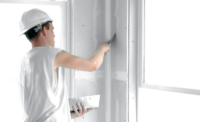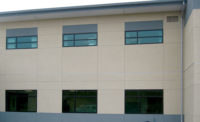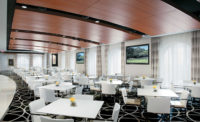I have been in the drywall business for a few years now and I’m always amazed by how reluctant people are to change. New is not always best but you have to be open to change.
I was walking through a plant recently when I spotted a procedure that looked a little off. I asked the employee how long they had been doing it this way, and he answered, “Since forever.” I get the same kind of reaction when I ask different applicators why they install metal cornerbeads in bathrooms, basements and garages, “Because we’ve always done it that way.”
Which brings me to a relevant question in the drywall industry: why do people still install steel cornerbead in areas of high humidity?
I realize some contractors choose to install plastic bead and trim throughout entire jobs, but for many, steel is still the most commonly installed bead and trim.
Despite the occasional architect’s specification, most of the time the drywall contractor can install what they feel most comfortable with. Rarely does someone want to buy two boxes of steel and eight pieces of plastic cornerbead. So, is installing steel cornerbead in the bathroom still the correct thing to do?
I Found Out the Hard Way
Recently, I was in the process of remodeling two bathrooms in my home. Even though I diligently kept the paint fresh for 30 years, the corners were completely covered with rust. Rusty corners with half of the bead under a tile are not a quick, simple fix. End result: I had to gut bathrooms, replacing all of the old, rusty metal bead and trim with vinyl along the way. I did this for the aesthetics, of course, but also another reason—sustainability.
If you look up “sustainability,” most of the descriptions or definitions say everything but what the word actually means. Sustainability doesn’t just apply to environmentally-conscious materials. In the drywall industry, sustainability translates into building a structure and using materials that will stand up to climate stress and daily abuse. In fact, the ASTM Sustainability Committee (E60) is beginning to build guides to help evaluate the resiliency of products and materials. These guides will be relevant to all application and market segments, and the proposed standard’s goal, WK54254, is to help determine which materials and applications befit various applications. The construction industry is constantly improving design, operations and building materials more rapidly than ever before. Doing things because “we’ve always done them that way” just doesn’t fly anymore.
Let’s Break it Down
When you take a hot shower, about a pint of water is added to the air. The additional water molecules in the air must find a spot to “land.” Steam finds the coolest place possible to settle. If our walls rest at about 70 degrees, that’s where the droplets land–not just your mirrors and metal hardware.
Assuming there are two people per bathroom in your home, two showers a day equal 730 cups of water in one year alone. Bottom line, bathrooms get wet. Even though the wall and cornerbead are painted, over time this moisture works its way through the paint. The excess water will eventually breach the zinc coating of the galvanized steel and leave you with rusty steel. That’s no good.
But high humidity areas aren’t just limited to the bathroom:
- Basements in Older Homes: Basements are higher in humidity than the rest of the house. Humid air is heavy and settles to the lowest level of the home. Also to note: moisture can and will migrate through the walls from the ground surrounding the basement walls in older homes.
- Garages: Garages are another prime area for wet and dirty floors. Rain or snow, the car gets pulled in, and whatever is on it usually ends up on the floor in one form or another.
- Outdoor Job Sites: Improperly stored materials or harsh, unpredictable weather can expose metal bead and products to moisture unexpectedly. Rust city.
Some other areas where moisture can be a problem:
- Coastal areas where salty air can lead to accelerated rusting
- Drywall returns around windows
- L-Trim touching the window instead of the gypsum board
- Overheated kitchens during the high volume holiday cooking (a personal favorite)
This leads us to a natural conclusion—use vinyl in these humid areas. Vinyl cornerbead is 100 percent rust-resistant, and excels in damp areas. Vinyl eliminates the probability of moisture-driven wall damage and discoloration. In addition to this, vinyl cornerbead and trim are not only sustainable in their resistance to moisture penetration, but also nod to ecofriendly sustainability. A majority of vinyl products are made from recycled plastics, about 70 to 80 percent, postindustrial. This allows punch-hole scraps and pieces trimmed or cut off in the manufacturing plant to be recycled again.
With sustainability being a major theme in the building industry, skipping over these details in wall and ceiling applications like drywall finishing accessories is a mistake. Vinyl products, windows, doors, gutters and siding, have been popular in exterior home building products for years. Such products have proven to hold up to whatever Mother Nature throws at them. Vinyl products for interior building products are coming of age. Oftentimes, they outperform the more historical products. So next time you are building a home, apartment, hospital, etc., remember that in areas of high humidity and exposure, “Vinyl is final.”







Report Abusive Comment